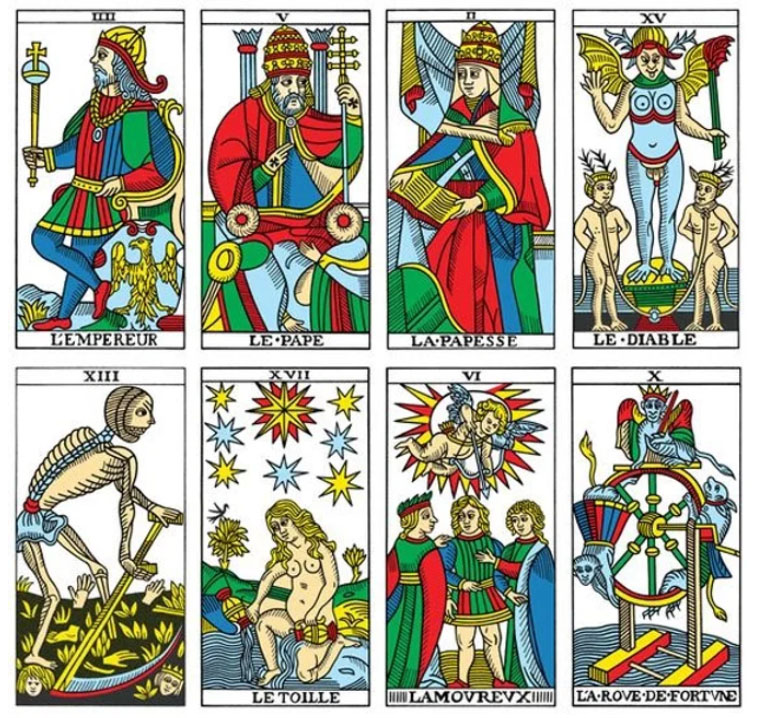WHAT IS TAROLOGY?
The study & practice of tarology is quite different from what is conventionally called ‘tarot reading’. What is special about Tarology?
TAROLOGY V TAROT READING (FORTUNE-TELLING)
When approaching the Tarot, the aim of the tarologist is to bring up something useful, something that can be explored to improve your situation. Our purpose is to offer more insight about your interests, to bring a clearer vision to your opportunities & challenges. We facilitate self-knowledge, providing new connections and stimulus to change your perceptions and behaviour so that you can live a more aware, more empowered life.
By contrast, conventional tarot reading, as in fortune-telling, is based in a simple question/response approach. Being told, rather than exploring together, reduces the consultee’s ability to self-transform and their agency in their own destiny. Tarology on the other hand fulfills potential best when it is collaborative.
So where do we start to understand how Tarologists work with the Tarot?
THE TAROLOGY’S APPLICATION
Our mindset or modus operandi is formed by symbolic associations. Through the symbolism of it, we can access emotions, different forms of thoughts, and the wide range of associations working as a network that creates our perceptions, resulting in our belief systems and consequently creating the core of our action, behavior and personalities.
The Tarot is essentially a projective instrument. Through its mirroring process, it allows us to access separate symbolic representations within our consciousness.
Symbols are abstractions of information that set up a person’s abstract processing system. We can think of these symbols as codes, and their network is the stimulus triggering our thoughts, physical sensations and reactions, which in turn creates a conditioned ‘program’ or behavior. The analogy we are making is that essentially, the human modus operandi is a kind of software that can be adjusted.
The Tarologist’s role is to translate the symbols and their network presented through the Tarot, as the means to explore the consultee’s experiences and unconscious patterns. And to bring up clarity to the consultee’s counciousness.
THE TAROT’S STRUCTURE AND SYMBOLISM

We should imagine the entire Tarot deck as a whole set of 78 cards, connected through each detail. They are arranged in suits like playing cards, but with 22 further cards named “The Major Arcana”, with extra “face cards” per suit.
The Major Arcana cards represent the most powerful archetypes within our psyches. They equate to elements which cause changes in our consciousness and lives. They resemble major story-line shifts in a film. You might think of them as the paths we take in our experience. The majors teach us the deepest lessons.
The Minor cards sit in four suits. Each suit resembles an area that is common to human experience: intellect, pleasure, creativity, willpower, emotions, health and our relationship with the material aspects of life.
Additionally, there are 16 “court” figure cards: Page, Queen, King and Knight. They represent social levels and power, as well as different personalities’ maturity, strengths, weaknesses, advantages and challenges in roles.
THE TAROT’S ORIGIN
To imagine Tarot’s origin we need to go back at least to the year 1000, when in the south of France and in Spain it was possible to see a church, a synagogue and a mosque cohabitating in healthy conditions of peace and in close proximity. From this time, the Tarot derives Christian, Jewish and Muslim influences.
The Christian influence is obvious in many major Arcanas and Hebrew letters are seen in the nameless Arcana, with the Sephirots of the Kabbalistic Tree of Life on The Hanged Man’s chest. Muslim symbols appear in the Minor Arcana, such as on the top of the Ace of Cups, representing the initiatory enneagram.
It’s believed that a group of sages from the three faiths, foreseeing the decay of their religions and the forgetting of the sacred tradition, worked together to deposit this knowledge in a humble card game, to preserve and conceal it so that it could travel through the darkness of history. Until it reached a remote future, where individuals who know the meaning of symbols could decipher its wonderful message.*
SO WHAT’S SPECIAL ABOUT THE TAROT?
Tarology involves working towards realisations which are like revelations. Gathering up and reassembling fragments, putting the pieces of the self back together. In fact, we can think about the Tarot as if we were building a temple. In all traditions, the temple summarizes the creation of the universe, seen as a divine unit that has exploded into pieces. For example, Osiris, the Egyptian god, imprisoned in a chest by his jealous enemies and his brother Seth, was cast into the waters of the Nile, mutilated, dismembered, then resuscitated by the breath of Isis. Symbolically, the Arcana of the Tarot are a chest in which a spiritual treasure has been deposited. The opening of the chest is the start of our quest. *
“ It seemed to me that instead of using the tarot like a crystal ball, making it a tool that enabled exotic seers to penetrate hypothetical futures, I would put it into service for a new form of psychoanalysis: Tarology.”